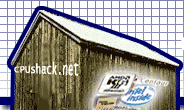


 |
 |
 |
| home | about | pictures | reference | trade | links |
SANTA CLARA, Calif., March 24, 1997 -- Quantum Effect Design, Inc. (QED) today announced two new members of its RISCMark brand MIPS® architecture microprocessor family - the RM5230 and RM5260. The RM5230 and RM5260 are derivatives of the R5000, which is currently shipping in high-performance systems including Silicon Graphics, Inc.'s O2 workstation and Cisco's 7500 high-performance routers. The RM52xx family provides workstation-class superscalar microprocessor performance at an affordable price and is targeted at high-end embedded applications such as internetworking, printers, games, Internet TV/set-top boxes/cable modems and other high-speed communications devices markets.
The RM52xx family features a superscalar instruction issue architecture that increases processor efficiency and performance. This architecture enables one integer and one floating point instruction to be processed within one microprocessor clock cycle, thereby achieving higher system performance without increasing clock speed. Superscalar processing is important for numeric algorithms found in DSP, imaging and 3-D applications as it enables computation and operand access to occur in parallel.
QED also announced it has established a North American sales network to sell its RISCMark labeled products.
"We have found many customers who want the workstation-class floating-point and integer performance of a superscalar 64-bit CPU, but need different memory architectures to meet system cost requirements," said Tom Riordan, QED president and CEO. "The RM5230 and RM5260 are excellent choices for customers who want the flexibility of developing or maintaining common software across multiple hardware platforms to meet different price/performance points."
"The RM5230 microprocessor was designed and first samples were delivered to customers within 6 months," stated Riordan. "QED has responded to customers' demands for quick time-to-volume by rapidly designing and delivering high-performance embedded microprocessors that meet multiple price/performance points. The RM5230 and RM5260 were designed using QED's "Quick-Turn Microprocessor" technology, based on the 'simple is better' design approach, and a design methodology that allows microprocessors to be easily ported to multiple foundries."
RM5230 Product Description
The RM5230 is a high-performance superscalar 64-bit microprocessor with a 32-bit memory interface and an estimated 2.7 SPECint95 rating, 2.5 SPECfp95 rating and 175 Dhrystone 2.1 MIPS performance at 133 MHz. It has 2.5 W typical power consumption at 3.3V and 133 MHz. It implements a DSP-enhanced MIPS IV instruction set architecture that includes the "Multiply/Add" (MULADD) and "Three-Operand Multiply" instructions.
Key features of the RM5230 include: superscalar instruction issue, 5V tolerant I/Os, 16KB instruction cache and 16KB data cache (both 2-way set associative), full-featured MMU compatible with the R4600, R4700 and R5000 microprocessors, low system cost 32-bit memory interface with 67 MHz maximum operation and 1149.1 compliant JTAG boundary scan functionality for manufacturing testing. The RM5230 is manufactured using leading-edge 0.35 micron technology at TSMC (Taiwan) with assembly and testing at Amkor/Anam (Korea).
RM5260 Product Description
The RM5260 is a high-performance superscalar 64-bit microprocessor with a 64-bit memory interface and an estimated 3.0 SPECint95 rating, 2.8 SPECfp95 rating and 200 Dhrystone 2.1 MIPS performance at 150 MHz. It has a 2.8 W typical power consumption at 3.3V and 150 MHz. It implements a DSP-enhanced MIPS IV instruction set architecture that includes the "Multiply/Add" (MULADD) and "Three-Operand Multiply" instructions.
Key features of the RM5260 include: superscalar instruction issue, 5V tolerant I/Os, 16KB instruction cache and 16KB data cache (both 2-way set associative), full-featured MMU compatible with the R4600, R4700 and R5000 microprocessors, high-performance 64-bit memory interface with 75 MHz maximum operation and 1149.1 compliant JTAG boundary scan functionality for manufacturing testing. The RM5260 is manufactured using leading-edge 0.35 micron technology at TSMC (Taiwan) with assembly and testing at Amkor/Anam (Korea).
RM52xx Product Family: Targeted At High-End Embedded Market
"Customers like the fact that in 1996, over 19.2 million MIPS RISC processors were shipped making the MIPS architecture the fastest-growing RISC architecture in the world," said Rick Kepple, QED vice president of marketing and sales. "We have seen other microprocessor architectures run out of gas when it comes to meeting the performance requirements of the high-end embedded market. Customers want more than promises of roadmaps, they want to know their strategic investment in a microprocessor architecture will be protected in the long term. QED's RM52xx family of high-performance MIPS architecture microprocessors are providing such a roadmap today ."
"Looking beyond our current offering of high-performance microprocessors, QED is evaluating whether to add architectural extensions like MDMX or MIPS16 and/or possibly integrate system functions like PCI and SDRAM to our microprocessors," Kepple stated. "These new products will help meet the market demand for affordable high-performance microprocessors."
Tools Support for RM5230 and RM5260
QED is supporting embedded designers' requirements with a wide range of software and hardware tools for the RM5230 and RM5260. Algorithmics, Ltd. (London, UK), in cooperation with QED, currently supports the RM5230 with its "SDE-MIPS" Compiler, Assembler, Linker and Debugger software tools and hardware evaluation board. Algorithmics is also slated to provide the RM5260 versions of the SDE-MIPS software development tools and hardware evaluation board in 2Q97. Galileo Technology, Inc. (San Jose, CA) is planning to provide a RM5260 hardware evaluation board with RTOS support in 2Q97.
Debugging support is available for both Hewlett-Packard and Tektronix logic analyzers. Pre-processor pods and disassembler software for Hewlett-Packard logic analyzers are available from Corelis (Cerritos, CA). Adapter pods and disassembler software for Tektronix logic analyzers are available from Crescent Heart Software (Portland, OR).
Packaging, Availability and Pricing
Samples of the RM5230 are available now, with production volumes scheduled for Q3 97. The RM5230 is available at 100 and 133 MHz in a 128-pin Power-Quad 4 package with prices starting below $35 in 10,000-piece quantities.
Samples of the RM5260 are available now, with production volumes
scheduled for Q3 97. The RM5260 is available at 133 and 150 MHz
in a 208-pin Power-Quad 4 package with prices starting below $75
in 10,000-piece quantities.
About Quantum Effect Design, Inc.
Quantum Effect Design, Inc., founded in 1991, designs, develops and markets high-performance, cost-effective, market-driven embedded microprocessor solutions.
The company designed and developed many of the 64-bit MIPS microprocessors
including the popular R4600, R4700, R4650 , R4640, R5000 and under
its own "RISCMark" label, the RM5230, RM5260 and RM7000.
Quantum Effect Design's RM52xx and RM7000 product families
include high-end, 32- and 64-bit embedded microprocessors targeted
at emerging and fast-growing markets such as internetworking,
printers, games, Internet TV/set-top boxes/cable modems and high-speed
communications devices. The company has an unsurpassed record
of designing and delivering innovative high-performance microprocessors
in breakthrough time-to-volume.
Company headquarters are located in Santa Clara, California. Telephone: 408/565-0300.
MIPS is a registered trademark and R5000 a trademark
of MIPS Technologies, Inc., R4600, R4700, R4650, and R4640 are
trademarks of Integrated Device Technology, Inc., and RISCMark,
RM5230, RM5260, RM52xx and RM7000 are trademarks of Quantum Effect
Design, Inc. and O2 is a trademark of Silicon Graphics, Inc.
and Power-Quad 4 is a trademark of Amkor/Anam